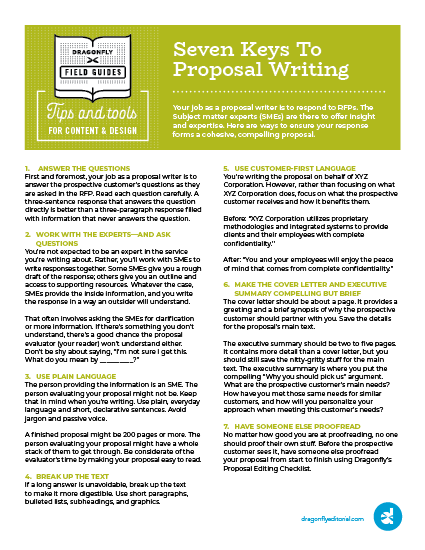Your job as a proposal writer is to respond to requests for proposals (RFPs). But you won’t do this alone—you’ll have subject matter experts (SMEs) to lean on. Together, you’ll create clear, concise answers that form a cohesive, compelling proposal.
1: ANSWER THE QUESTIONS
First and foremost, your job as a proposal writer is to answer the prospective customer’s questions as they are asked in the RFP. Read each question carefully. A three-sentence response that answers the question directly is better than a three-paragraph response filled with information that never answers the question.
2: WORK WITH THE EXPERTS—AND ASK QUESTIONS
You’re not expected to be an expert in the service you’re writing about. Rather, you’ll work with SMEs to write responses together. Some SMEs give you a rough draft of the response; others give you an outline and access to supporting resources. Whatever the case, SMEs provide the inside information, and you write the response in a way an outsider will understand. That often involves asking the SMEs for clarification or more information. If there’s something you don’t understand, there’s a good chance the proposal evaluator (your reader) won’t understand. Don’t be shy about saying, “I’m not sure I get this. What do you mean by __________?”
3: USE PLAIN LANGUAGE
The person providing the information is a SME. The person evaluating your proposal might not be a SME. Keep that in mind when you’re writing. Use plain, everyday language and short, declarative sentences. Avoid jargon and passive voice. A finished proposal might be 200 pages or more. The person evaluating your proposal—who works for the prospective customer—might have a whole stack of proposals to get through. Be considerate of their time by making your proposal easy to read.
4: BREAK UP THE TEXT
If a long answer is unavoidable, break up the text to make it more digestible. Use short paragraphs, bullet lists, subheadings, and graphics.
5: USE CUSTOMER-FIRST LANGUAGE
You’re writing the proposal on behalf of XYZ Corporation. However, rather than focusing on what XYZ Corporation does, focus on what the prospective customer receives and how it benefits them.
Before: “XYZ Corporation utilizes proprietary methodologies and integrated systems to provide clients and their employees with complete confidentiality.”
After: “You and your employees will enjoy the peace of mind that comes from complete confidentiality.”
6: MAKE THE COVER LETTER AND EXECUTIVE SUMMARY COMPELLING BUT BRIEF
The cover letter should be about a page. It provides a greeting and a brief synopsis of why the prospective customer should partner with you. Save the details for the proposal’s main text. The executive summary should be two to five pages. It contains more detail than a cover letter, but you should still save the nitty-gritty stuff for the main text. The executive summary is where you put the compelling “Why you should pick us” argument. What are the prospective customer’s main needs? How have you met those same needs for similar customers, and how will you personalize your approach when meeting this customer’s needs?
7: HAVE SOMEONE ELSE PROOFREAD
No matter how good you are at proofreading, no one should proof their own stuff. Before the prospective customer sees it, have someone else proofread your proposal from start to finish using Dragonfly’s Proposal Editing Checklist Field Guide.


